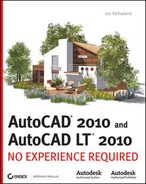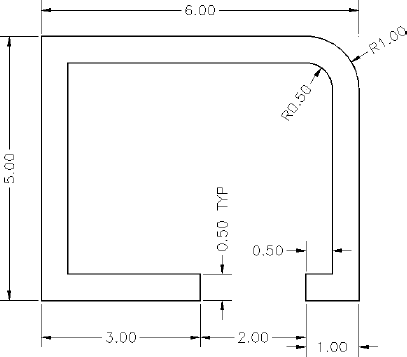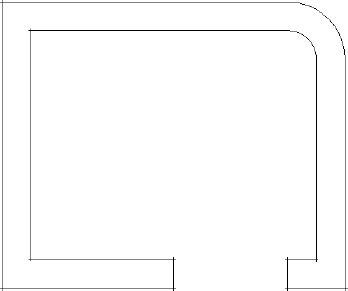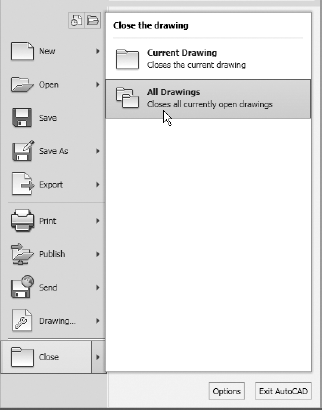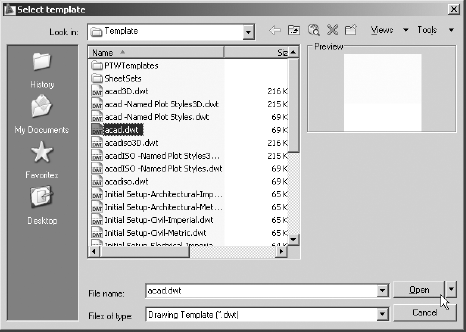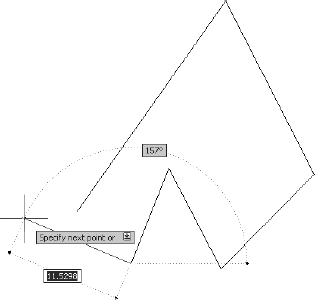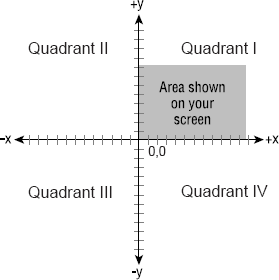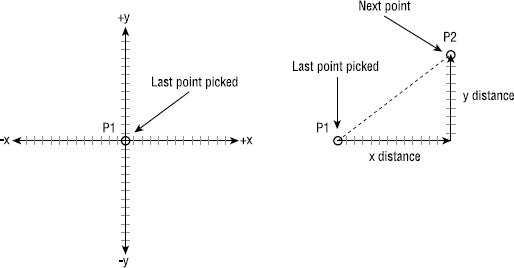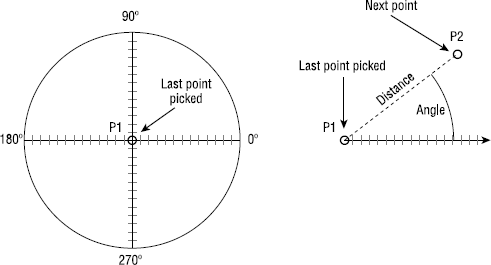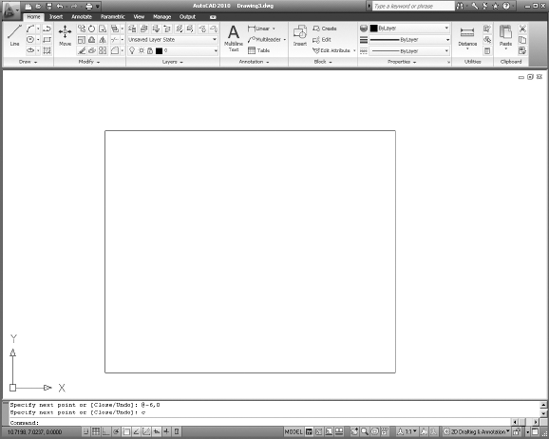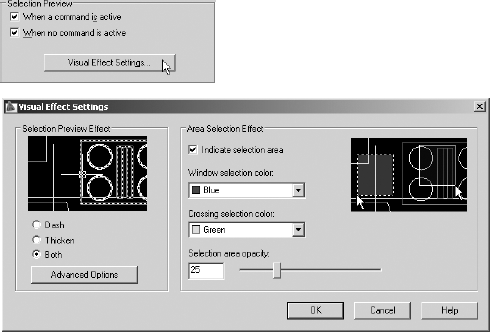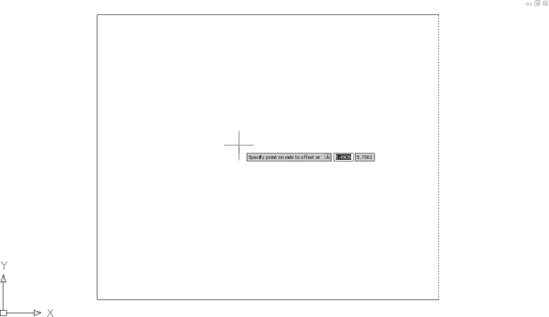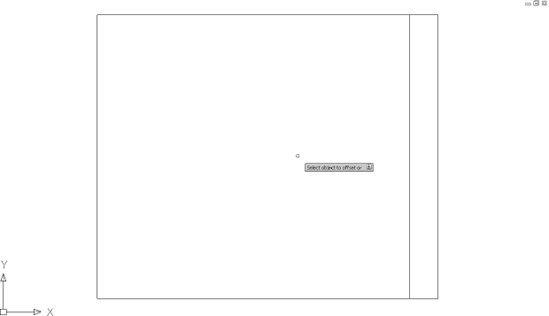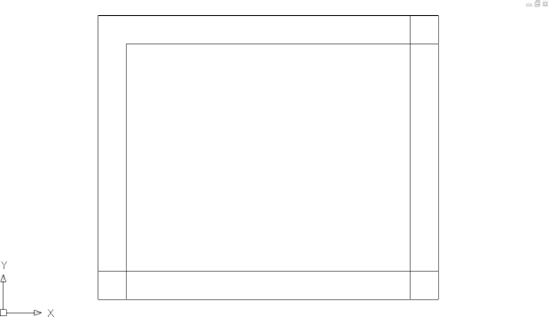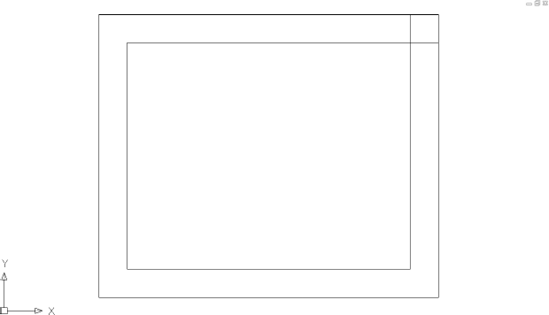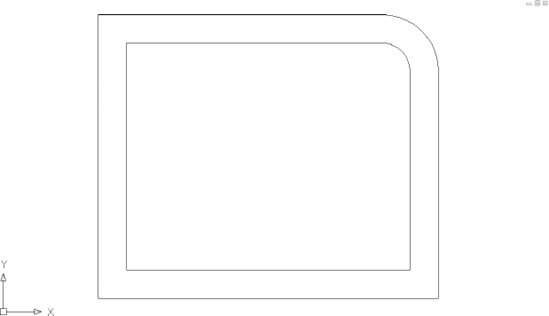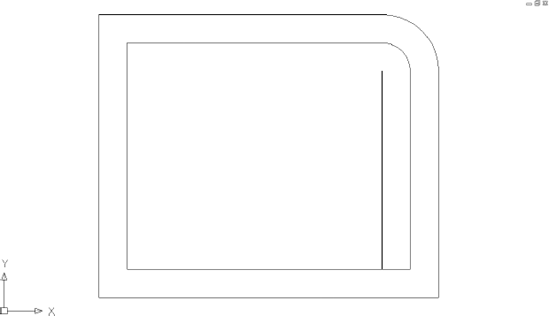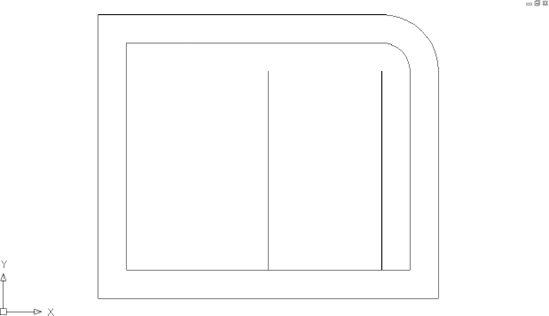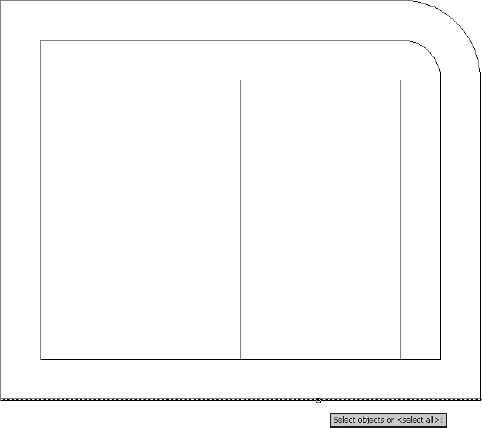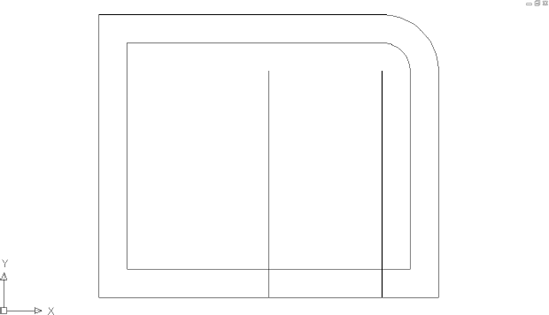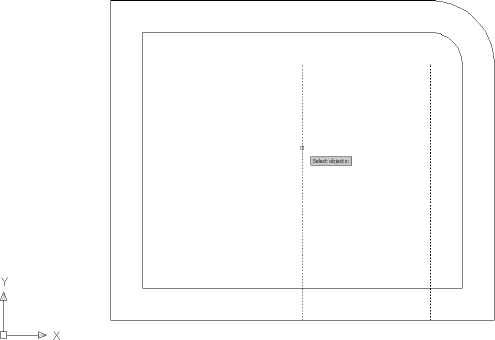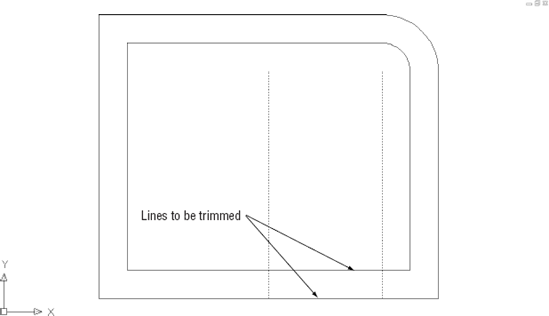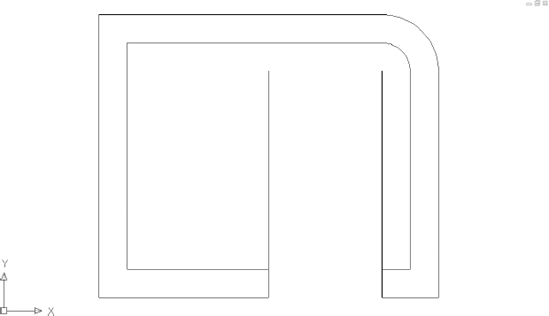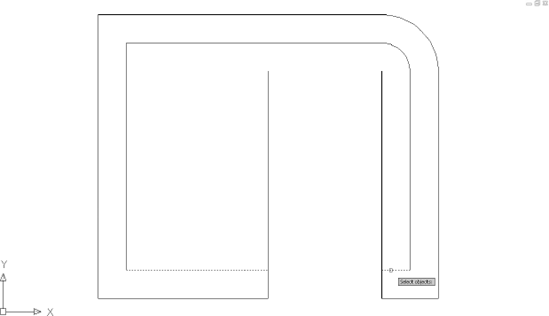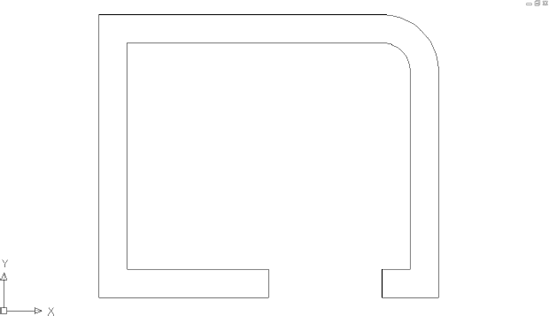Understanding coordinate systems
Drawing your first object
Erasing, offsetting, filleting, extending, and trimming objects in a drawing
Now that you've taken a quick tour of the AutoCAD and LT screens, you're ready to begin drawing. In this chapter, you'll be introduced to a few basic commands used in drawing with AutoCAD and AutoCAD LT. To get you started, I'll guide you through the process of drawing a simple shape (see Figure 2.1).
You will need to use only five or six commands to draw the box. First you'll become familiar with the Line command and how to make lines a specific length. Then I'll go over the strategy for completing the form.
In traditional architectural drafting, lines were often drawn to extend slightly past their endpoints (see Figure 2.2). This is rarely done in CAD nowadays except as a special effect.
The Line command draws a straight line segment between locations on existing objects, geometric features, or two points that you can choose anywhere within the drawing area. You can designate these points by left-clicking them on the screen, by entering the x- and y-coordinates for each point, or by entering distances and angles from an existing point. After you draw the first segment of a line, you can end the command or draw another line segment beginning from the end of the previous one. You can continue to draw adjoining line segments for as long as you like. Let's see how this works.
To be sure that you start with your drawing area set up the way it's set up for this book, expand the Application menu (the red A button in the top-left corner of the AutoCAD user interface) and then choose Close
If multiple drawings are open, and you want to close each one individually, choose Close

Glance at the status bar at the bottom of your screen. On the right side, all buttons except Model should be off—that is, in an unpushed state. If any of the others appear to be pushed, click on them to turn them off.
On the left side, some of the tools, such as Object Snap and Dynamic Input, are turned on while others remain off. Make sure that Polar Tracking, Object Snap, Object Snap Tracking, Allow/Disallow Dynamic UCS, and Dynamic Input are turned on and all the others are turned off. You can identify the buttons by pausing over each and exposing its tooltip. Your AutoCAD window should look similar to Figure 2.5.

Tip
You can also start the Line by typing line or l and pressing the Enter key or the right mouse button.
The prompt now tells you that the Line command is started (
Command: _line) and that AutoCAD is waiting for you to designate the first point of the line (Specify first point:).Move the cursor onto the drawing area and notice that the small box at the intersection of the crosshairs is not there.
When the cursor is used to select objects, the default condition, the pickbox appears in the cursor. When the cursor is used to designate a point, the pickbox is not visible. Using the left mouse button, click a random point in the drawing area to start a line.
Move the cursor away from the point you clicked and notice how a line segment appears that stretches like a rubber band from the point you just picked to the cursor. The line changes length and direction as you move the cursor, and these values are shown as input boxes in the drawing area.
Look at the Command window again and notice that the prompt has changed (see Figure 2.7).
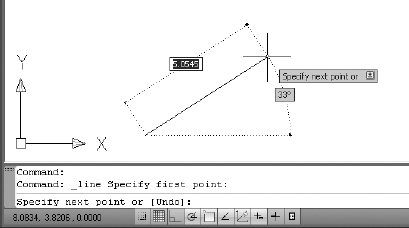
Figure 2.7. The command prompt changes for the next point, and the line's length and direction are shown in the drawing area.
It's now telling you that AutoCAD is waiting for you to designate the next point (
Specify next point or [Undo]:).Continue picking points and adding lines as you move the cursor around the screen (see Figure 2.8). After you draw the second segment, the Command window repeats the
Specify next point or [Close/Undo]:prompt each time you pick another point. The Dynamic Input fields and command prompt appear near the cursor, showing the angle and distance from the last point selected.When you've drawn six or seven line segments, press Enter to end the Line command. The cursor separates from the last drawn line segment.
The command prompt has returned to the bottom line. This tells you that no command is currently running.
Tip
The Enter key exits the Line command and several others. Another option is to right-click and choose Enter from the context menu. This may require an extra step, but it may still be faster because your eyes never leave the screen. When you're not entering data, the spacebar also acts like the Enter key and executes a command.
In this exercise, you used the left mouse button to click the Line button on the Ribbon and also to pick several points in the drawing area to make the line segments. You then pressed Enter (
Note
In the exercises that follow, the Enter symbol (
A coordinate system consists of numbered scales that identify an initial, or base, point and the direction for measuring subsequent points on a graph. The Cartesian Coordinate System, named after the philosopher René Descartes, who defined the x,y-coordinate system in the 1600s, consists of three numbered scales, called the x-axis, y-axis, and z-axis, that are perpendicular to each other and extend infinitely in each direction. Each pair of axes (xy, xz, yz) forms a flat plane. Most of your time using AutoCAD will be spent drawing in the xy plane.
The point where the scales intersect is called the origin. For each axis, all values on one side of the origin are positive, all values on the other side are negative, and values that fall in line with the origin have a value of 0 (zero). The divisions along the scales may be any size, but each division must be equal. The axes divide the coordinate system into four regions called quadrants. Quadrant I is the region above the x-axis and to the right of the y-axis. Quadrant II is the region above the x-axis and to the left of the y-axis. Quadrant III is the region below the x-axis and to the left of the y-axis. Quadrant IV is the region below the x-axis and to the right of the y-axis. Most of your work in AutoCAD will be done in Quadrant I, and this is the area shown when you first open a drawing.
Any point on a graph can be specified by giving its coordinates relative to the origin given as a combination of the X value and the Y value delineated with a comma. For example, a coordinate of 5,7 means a point on the coordinate system that is 5 units in the positive X direction and 7 units is the positive Y direction. Figure 2.9 shows a typical Cartesian coordinate system and the default region used as the drawing area in a new AutoCAD file.
Note
In AutoCAD, you see a readout for the z-coordinate as well, but you can ignore it for now because you'll be working in only two dimensions for the majority of this book. The z-coordinate always reads 0 until you work in three dimensions. (This will be covered in the later chapters.) AutoCAD LT doesn't have the readout for the z-coordinate because it doesn't have 3D capabilities.
In this next exercise, you'll try using the Line command again, but instead of picking points in the drawing area with the mouse as you did before, this time enter x- and y-coordinates for each point from the keyboard. To see how to do this, follow these steps:

Enter all

Press


Now begin drawing lines again by following these steps:
Start the Line command by clicking the Line button on the Draw panel of the Ribbon.
Enter 2,2

Enter 6,3

Enter 4,6

Enter 1,3

Enter 10,6

Enter 10,1

Enter 2,7

Press

The lines are similar to those you drew previously, but this time you know where each point is located relative to the 0,0 point. In the drawing area, every point has an absolute x- and y-coordinate. In steps 2 through 8, you entered the x- and y-coordinates for each point. For a new drawing such as this one, the origin (0,0 coordinate) is in the lower-left corner of the drawing area and all points in the drawing area have positive x- and y-coordinates.
Let's explore how the cursor is related to the coordinates in the drawing.
At the command prompt, enter zoom

Move the cursor around, and notice the left end of the status bar at the bottom of the screen. This is the coordinate readout, and it displays the coordinates of the cursor's position, as shown in Figure 2.10.
Move the cursor as close to the lower-left corner of the drawing area as you can without it changing into an arrow. The coordinate readout should be close to 0.0000, 0.0000, 0.0000.
Move the cursor to the top-left corner of the drawing area. The readout changes to something close to 0.0000, 7.0000, 0.0000, indicating that the top of the screen is 7 units from the bottom.
Move the cursor one more time to the upper-right corner of the drawing area. The readout still has a y-coordinate of approximately 7.0000. The x-coordinate now has a value around 10.5.
The drawing area of a new drawing is preset with the lower-left corner of the drawing at the coordinates 0,0.
Note
For the moment, it doesn't matter what measure of distance these units represent. I'll address that topic in Chapter 3, "Setting Up a Drawing." Don't worry about the four decimal places in the coordinate readout; the number of places is controlled by a setting you'll learn about soon.
Once you understand the coordinate system used by AutoCAD, you can draw lines to any length and in any direction. Look at the shape shown earlier in Figure 2.1. Because you know the dimensions, you can calculate, by adding and subtracting, the absolute coordinates for each vertex—the connecting point between two line segments—and then use the Line command to draw the shape by entering these coordinates from the keyboard. However, AutoCAD offers you several tools for drawing this box much more easily. Two of these tools are the relative Cartesian and the relative polar coordinate systems.
When you're drawing lines, these coordinate systems use a set of new points based on the last point designated, rather than on the 0,0 point of the drawing area. They're called relative systems because the coordinates used are relative to the last point specified. If the first point of a line is located at the coordinate 4,6, and you want the line to extend 8 units to the right, the coordinate that is relative to the first point is 8,0 (8 units in the positive x direction and 0 units in the positive y direction), whereas the actual—or absolute—coordinate of the second point is 12,6.
The relative Cartesian coordinate system uses relative x- and y-coordinates in the manner shown, and the relative polar coordinate system relies on a distance and an angle relative to the last point specified. You'll probably favor one system over the other, but you need to know both systems because you'll sometimes find that, given the information you have at hand, one will work better than the other. A limitation of this nature will be illustrated in Chapter 4, "Developing Drawing Strategies: Part 1."
When entering relative coordinates, with the Dynamic Input tool turned off, you need to enter an "at" symbol (@) before the coordinates. In the previous example, you would enter the relative Cartesian coordinates as @8,0. The @ lets AutoCAD know that the numbers following it represent coordinates that are relative to the last point designated. When the Dynamic Input tool is turned on, relative coordinates are employed and the @ symbol is not required.
The Cartesian system of coordinates uses a horizontal (x) component and a vertical (y) component to locate a point relative to the 0,0 point. The relative Cartesian system uses the same components to locate the point relative to the last point picked, so it's a way of telling AutoCAD how far left or right and up or down to extend a line or to move an object from the last point picked (see Figure 2.11). If the direction is to the left, the x-coordinate will be negative. Similarly, if the direction is down, the y-coordinate will be negative. Use this system when you know the horizontal and vertical distances from point 1 to point 2. To enter data using this system, use this form: @x,y.
This system requires a known distance and direction from one point to the next. Calculating the distance is straightforward: it's always positive and represents the distance away from the first point that the second point will be placed. The direction requires a convention for determining an angle. AutoCAD defines right (toward three o'clock) as the default direction of the 0° angle. All other directions are determined from a counterclockwise rotation (see Figure 2.12). On your screen, up is 90°, left is 180°, down is 270°, and a full circle is 360°. To let AutoCAD know that you're entering an angle and not a relative y-coordinate, use the less-than symbol (<) before the angle and after the distance. Thus in the previous example, to designate a point 8 units to the right of the first point, you would enter @8<0 or simply 8<0 when the Dynamic Input tool is active.
You can also draw lines by placing the cursor at any angle relative to the last point and entering a distance value at the command prompt. The line is drawn from the last point toward or through the cursor location at the length specified. The Direct Distance method is often used when either Ortho mode or polar tracking is turned on.
Note
When in a drawing command, Ortho mode restricts the cursor to horizontal or vertical movements. Lines, for example, can only be drawn at 0°, 90°, 180°, and 270°. Ortho mode is toggled on using the Ortho Mode button at the bottom of the user interface (UI) or by pressing the F8 key.
Now that you have the basics, the following exercises will take you through the steps to draw the four lines that form the outline of the shape using both relative coordinate systems.
To begin drawing the box, use the same drawing:
If your drawing is already blank, jump to step 2. If you still have lines on your drawing, start the Erase command, enter all

Start the Line command.
At the
Specify first point:prompt in the Command window, enter 3,3
Enter @6,0

Enter @0,5

Turn on the Dynamic Input tool in the status bar and, if necessary, scroll the mouse wheel to zoom out to see the extents of the lines.
Enter −6,0

Look at the command prompt. It reads:
Specify next point or [Close/Undo]:. Items enclosed in brackets are additional available options at that particular point of the command that can be entered at the command prompt. Only the capitalized letters are required to execute an option.Enter c

To prepare to draw the box again, use the Erase command to erase the four lines you just drew:
Start the Erase command. Notice how the cursor changes from the crosshair to a little square. This is called the pickbox. When you see it on the screen, it's a sign that AutoCAD is ready for you to select objects on the screen. Also notice the Command window; it's prompting you to select objects.
Place the pickbox on one of the lines, and click it when it highlights. The line changes to a dashed line to indicate that it is selected.
Repeat step 2 with the rest of the lines.
Press

Note
You've been introduced to two methods of selecting lines to be erased: typing all
When you move the cursor over an object, AutoCAD highlights the object. This is called rollover highlighting. It tells you that clicking while the object is high-lighted selects that object. You have some choices as to how this highlighting appears:
In the Application menu, click the Options button at the bottom to open the Options dialog box.
Click the Selection tab. Notice the Selection preview area in the middle of the left side (see Figure 2.14, top). Here you can activate or deactivate the check boxes to control whether rollover highlighting occurs when a command is running or when no command is running. If both check boxes are checked, the feature works all the time.
Click the Visual Effect Settings button below the check boxes to open the Visual Effect Settings dialog box (see Figure 2.14, bottom). There are two areas: Selection Preview Effect and Area Selection Effect. The Selection Preview Effect area controls how the rollover highlighting feature is displayed. Lines dash, lines thicken, and lines both dash and thicken, depending on which radio button is selected.
Make any changes you want, and then click OK. Back in the Options dialog box, click OK to return to your drawing.
Now draw the shape again using the relative polar method by following these steps:
Start the Line command.
Enter 3,3

Enter 6<0

Enter 5<90

Enter 6<180

Enter c

You can see from this exercise that you can use either method to draw a simple shape. When the shapes you're drawing get more complex and the amount of available information about the shapes varies from segment to segment, one of the two relative coordinate systems will turn out to be more appropriate. As you start drawing the floor plan of the cabin in Chapters 3 and 4, you'll get more practice using these systems.
Now draw the box once more, this time using the direct input method by following these steps:
Erase the lines in your drawing as you did in a prior exercise.
Make sure Polar Tracking is turned on; then start the Line command.
Enter 3,3

Place the cursor so that it is directly to the right of the first point. When the cursor is nearly perpendicular, it will snap to a perfectly horizontal orientation. The Dynamic Input field shows a value of 0° and the distance from the first point, as shown in Figure 2.15.
Enter 6

Move the cursor so that it is directly above the last point until the angle field reads 90°; then enter 5

Move the cursor so that it is directly to the left of the end of the last line drawn and then enter 6

Enter c

You can see from these exercises that you can use multiple methods to draw a simple shape. When the shapes you're drawing get more complex and the amount of available information about the shapes varies from segment to segment, one method or another will turn out to be more appropriate. As you start drawing the floor plan of the cabin in Chapters 3 and 4, you'll get more practice using these systems.
Some additional tools make the process of drawing simple, orthogonal lines like these much easier. I'll introduce these tools in the following three chapters.
The next task is to create the lines that represent the inside walls of the box. Because they're all equidistant from the lines you've already drawn, the Offset command is the appropriate command to use. You'll offset the existing lines 0.5 units to the inside.
The Offset command involves three steps:
Setting the offset distance
Selecting the object to offset
Indicating the offset direction
Here's how it works:

Enter 0.5

Place the pickbox on one of the lines, and click it when it highlights. The selected line appears dashed to indicate that it is selected (see Figure 2.16), the cursor changes back to the crosshair, and the prompt changes to
Specify point on side to offset or [Exit/Multiple/Undo] <Exit>:. AutoCAD is telling you that to determine the direction of the offset, you must specify a point on one side of the line or the other. You make the choice by selecting anywhere in the drawing area on the side of the line where you want the offset to occur.Click a point somewhere inside the box. The offset takes place, and the new line is exactly 0.5 units to the inside of the chosen line (see Figure 2.17). Notice that the pickbox comes back on. The Offset command is still running, and you can offset more lines the same distance.
You have three more lines to offset.
Click another line; then click inside the box again. The second line is offset.
Click a third line, click inside the box; click the fourth line, and then click again inside the box (see Figure 2.18).
Press

This command is similar to the Line command in that it keeps running until it's stopped. With Offset, after the first offset, the prompts switch between Select object to offset or [Exit/Undo] <Exit>: and Specify point on side to offset or [Exit/Multiple/Undo] <Exit>: until you press
The inside lines are now drawn, but to complete the box, you need to clean up the intersecting corners. To handle this task efficiently, you'll use a tool called the Fillet command.
The Fillet command lets you round off a corner formed by two lines. You control the radius of the curve, so if you set the curve's radius to zero, the lines form a sharp corner. In this way, you can clean up corners such as the ones formed by the lines inside the box. You must pick points on the filleted lines on portions that will remain after the fillet is implemented; otherwise the wrong portion of the line may be retained.

The default fillet radius should be 0.0000 units. Like the Offset distance, the Fillet radius remains set at whatever value you specify until you change it.
If your Command window displays a radius of 0.0000, go on to step 3. Otherwise, enter r

Tip
When the radius value is set higher than 0, you can temporarily override this by holding the Shift key down while picking the two objects to be filleted. They will be filleted with a radius of 0 while the value set in the Fillet command remains unchanged.
Move the cursor—now a pickbox—to the shape, and click two intersecting lines, as shown in Figure 2.20. The intersecting lines are both trimmed to make a sharp corner (see Figure 2.21). The Fillet command automatically ends.
Press

Fillet the lower-left and lower-right crossing lines to clean up those corners (see Figure 2.22) and press

Tip
In most cases, you'll get the same effect by pressing the spacebar as you get by pressing

Note
If you make a mistake and pick the wrong part of a line or the wrong line, press Esc to end the command and then enter u

Press

Restart the command, set the radius to 1.0, and then fillet the outer upper-right corner. Your box should look like Figure 2.23.
Used together like this, the Offset and Fillet commands are a powerful combination of tools to lay out walls on a floor plan drawing. Because these commands are so important, let's take a closer look at them to see how they work. Both commands are in the Modify panel of the Ribbon and in the Modify menu of the Menu bar, both have the option to enter a numeric value or accept the current value—for offset distance and fillet radius—and both hold that value as the default until it's changed. However, the Offset command keeps running until you stop it, and the Fillet command stops after each use unless the Multiple option is invoked. These commands are two of the most frequently used tools in AutoCAD. You'll learn about more of their uses in later chapters.
The Fillet command has a sister command, Chamfer, which is used to bevel corners with straight lines. When the distances for the Chamfer command are set to 0, you can use the command to clean up corners the same way that you use the Fillet command. Some users prefer to use Chamfer rather than Fillet because they don't bevel corners, but they may at times use Fillet to round off corners. If you use Chamfer to clean up corners, Fillet can have any radius and won't have to be overridden or reset constantly to 0. You'll develop your own preference.
The final step in completing the box (see Figure 2.1 at the beginning of this chapter) is to make an opening in the bottom wall. From the diagram, you can see that the opening is 2 units wide and set off from the right inside corner by 0.5 units. To make this opening, you'll use the Offset command twice, changing the offset distance for each offset, to create marks for the opening.
Follow these steps to establish the precise position of the opening:
At the command prompt, start the Offset command. Notice the Command window. The default distance is now set at 0.5, the offset distance you previously set to offset the outside lines of the box to make the inside lines. If the distance is different, enter 0.5

Pick the inside vertical line on the right, and then pick a point to the left of this line. The line is offset to make a new line 0.5 units to its left (see Figure 2.24).
Press

Enter 2 as the new offset distance, and press

Click the new line, and then pick a point to the left. Press

You now have two new lines indicating where the opening will be. You can use these lines to form the opening using the Extend and Trim commands.
Tip
The buttons you've been clicking in this chapter are also referred to as icons and tools. When they're in dialog boxes or on the status bar, they have icons (little pictures) on them and look like buttons to push. When they're on the Ribbon or toolbars, they look like icons. But when you move the pointer arrow cursor onto one, it takes on the appearance of a button with an icon on it. I'll use all three terms—button, icon, and tool—interchangeably in this book.
You use the Extend command to lengthen (extend) lines to meet other lines or geometric figures (called boundary edges). Executing the Extend command may be a little tricky at first until you see how it works. Once you understand it, however, it will become automatic. The command has two steps: first, you pick the boundary edge or edges; second, you pick the lines you want to extend to meet those boundary edges. After selecting the boundary edges, you must press

Notice in the Command window that the bottom line says
Select objects or <select all>:, but in this case you need to observe the bottom two lines of text in order to know that AutoCAD is prompting you to select boundary edges (see Figure 2.26).Pick the very bottom horizontal line (see Figure 2.27), and press

Tip
The
Select Objects:prompt would be more useful if it said "Select objects and press Enter when finished selecting objects." But it doesn't. You have to train yourself to press
Pick the two new vertical lines created by the Offset command. Be sure to place the pickbox somewhere on the lower halves of these lines or AutoCAD will attempt to extend the opposite ends of the lines. Because there are no boundary edges that could intersect with extensions from the top end of the lines, AutoCAD will apparently ignore your picks if you select the wrong ends. The lines are extended to the boundary edge line.
Press

The final step is to trim away the horizontal lines to complete the opening and the unneeded portions of the two most recent vertical lines that you offset. To do this, you use the Trim command. As with the Extend command, there are two steps. The first is to select reference lines. In this case, they're called cutting edges because they determine the edge or edges to which a line is trimmed. The second step is to pick the lines that are to be trimmed.

Pick the two vertical offset lines that were just extended as your cutting edges, and then press

Pick the two horizontal lines across the opening somewhere between the cutting edge lines (see Figure 2.30).
Note
If you trim the wrong line, or the wrong part of a line, you can click the Undo button on the Quick Access toolbar on the left side of the AutoCAD title bar. This undoes the last trim without canceling the Trim command, and you can try again.
The opening is trimmed away (see Figure 2.31).
Now let's remove the extra part of the trimming guidelines.
Press

Pick the two upper horizontal lines next to the opening as your cutting edges, shown in Figure 2.32, and press

Pick the two vertical lines that extend above the new opening. Be sure to pick them above the opening (see Figure 2.33). The lines are trimmed away, and the opening is complete. Press

Congratulations! You've just completed the first drawing project in this book and covered all the tools in this chapter. These skills will be useful as you learn how to work on drawings for actual projects.
A valuable exercise at this time would be to draw this box two or three more times, until you can do it without the instructions. This will be a confidence-builder to get you ready to take on new information in the next chapter, in which you'll set up a drawing for a building.
The box you drew was 6 units by 5 units, but how big was it? You really don't know at this time because the units could represent any actual distance: inches, feet, meters, miles, and so on. Also, the box was positioned conveniently on the screen so you didn't have any problem viewing it. What if you were drawing a building that was 200′ (60.96 meters) long and 60′ (18.29 meters) wide or a portion of a microchip circuit that was only a few thousandths of an inch or millimeters long? In the next chapter, you'll learn how to set up a drawing for a project of a specific size.
A completed version of this exercise can be found in this book's web page, www.sybex.com/go/autocad2010ner, as Chapter02 Shape Completed.dwg.
You can save the file by clicking the Save button on the Quick Access toolbar or exit AutoCAD now without saving this drawing. To do the latter, expand the Application menu, and then click the Exit AutoCAD button in the lower-right corner. When the dialog box asks if you want to save changes, click No. Alternatively, you can leave AutoCAD open and go on to the following practice section or the next chapter.
Draw the object shown in Figure 2.35.
You can use the same tools and strategy used to draw the shape. Choose New from the Application menu to start a new drawing, and then use the acad.dwt template file. Here's a summary of the steps to follow:
Ignore the three openings at first.
Draw the outside edge of the shape using one of the relative coordinate systems. To make sure the shape fits on your screen, start the outline of the box in the lower-left corner at the absolute coordinate of 1,0.5.
Offset the outside lines to create the inside wall.
Fillet the corners to clean them up. (Lines that aren't touching can be filleted just like lines that intersect.)
Use the Offset, Extend, and Trim commands to create the three openings.
Feel free to check your work against Chapter02 More Practice Completed.dwg on this book's web page. Don't worry about trying to put in the dimensions, center line, or hatch lines. You'll learn how to create those objects later in the book.
